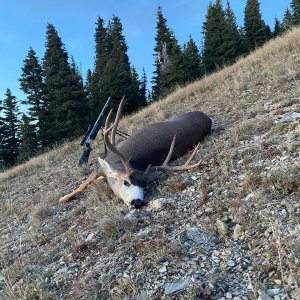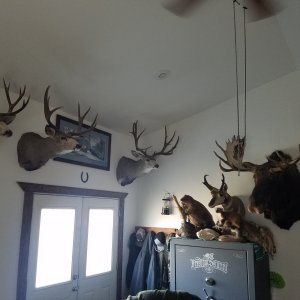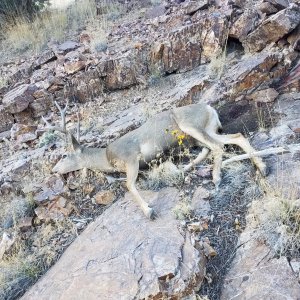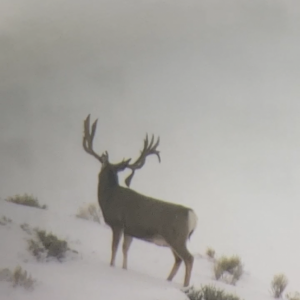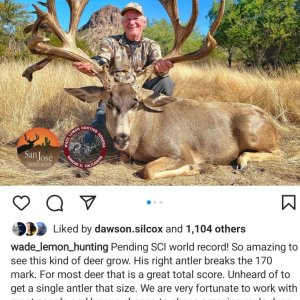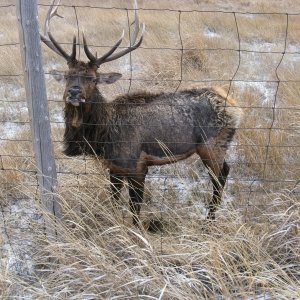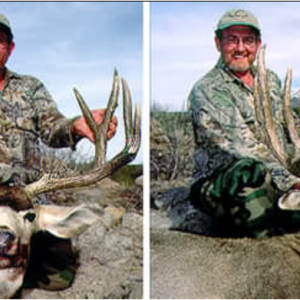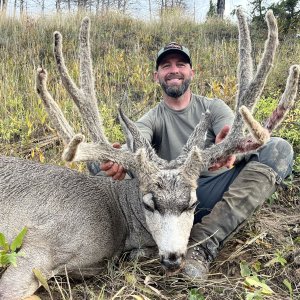Hiker of the Woods
Active Member
- Messages
- 623
Soils Helping Deer Antler Growth?
Here is a little information on soils and how they may help fit together part of the key when determining which new locations to scout and hunt for mature bucks that will reach their genetic potential.
Land surface shape and form should be considered into account. This is the slope (degree of incline or decline) and aspect (the compass direction a slope is facing). The slope and aspect of land surface will affect soil temperatures, moisture holding ability, affect rate of erosion, and decide movement of minerals and other particles from one area to another.
Vegetation affects soils by supplying organic debris to the soil. Grassland soils can have around twice the amount of organic matter compared to forest soils. The organic matter in grassland soils tend to be more uniformly distributed compared to forest soils. Grassland soils also tend to be less acid than forest soils.
The texture of a soil will affect the soil?s cohesiveness, aeration, drainage, and nutrient-holding capability. Here is a little information on soils:
Sand: Cohesiveness(Very little), Aeration(Very good), Drainage(Very good), Nutrients(Poor)
Silt: Cohesiveness(sticky when wet), Aeration(Average), Drainage(Average), Nutrients(Poor)
Clay: Cohesiveness(Very plastic), Aeration(Poor), Drainage(Very poor), Nutrients(High)
Loam: Cohesiveness(Good), Aeration(Good), Drainage(Good), Nutrients(Good)
Too much rain can lead to the leaching of ions and colloids. These are particles that play a key role in plant nutrition and soil chemistry. Waterlogged soils can cause poor aeration and lower the fertility of soil by lowering the ability to fix nitrogen.
Micro flora (algae, fungi, molds, and bacteria) capture atmospheric nitrogen that is vital for plant growth. Looking for types of habitats that include these micro floras; may mean deer are getting better nutrients in their diet and therefore may reach their genetic potential in antler growth.
Mycorrhizae are another key component of healthy soils. Mycorrhizae are important for disease suppression, drought protection, improved soil structure, increase leaf chlorophyll levels, and tolerance of nutrient imbalances. Undisturbed areas have plenty of mycorrhizae compared to disturbed sites. Disturbance from heavily compacted sites (such as some logging sites), areas that are treated with chemicals/pesticides, invasion by weeds, erosion, removal of topsoil, and land clearing are places where mycorrhizae are depleted; which causes plants to suffer.
Low intense fires can promote herbaceous flora, increase plant nutrients, and help healthy soil microbial systems. A severe/hot fire will do the opposite for a site.
Higher pH numbers around 8-14 indicate high levels of basic ions and soil alkalinity; which means low acidity. Colloids in this range will hold most of their mineral nutrients. The chemical environment in an area will determine if soil nutrients will be absorbed by plants. Most farm crops grow better around pH levels 6.5-6.8.
Soil erosion and nutrient depletion can be linked to intensive crop production (including tree farms), accelerated erosion, application of pesticides, and the uses of heavy machinery. Before humans took over the land; plants/trees would absorb nutrients from the soil and then would either drop their leaves or die, returning the nutrients back to the earth.
So know you know a few new things on what to look for when scouting for new areas to hunt deer. Here again is a short list of what to look for:
1. Clay or Loam soils
2. Neutral or alkaline pH soils
3. Soils with high levels of ions and colloids
4. Soils with high levels of micro flora and mycorrhizae
5. Areas with past low intense fires
Here are a few sites to help out in your search for the perfect new deer hunting location:
1. Soil Information: http://websoilsurvey.nrcs.usda.gov/app/HomePage.htm
2. Soil Map1: http://websoilsurvey.nrcs.usda.gov/app/WebSoilSurvey.aspx
3. Soil Map2: http://www.itc.nl/personal/rossiter/Docs/NRCS/maps.pdf
4. 12 Orders of Soil (goes with #3 & #7): http://soils.usda.gov/technical/soil_orders/
5. Fire Map1: http://www.inciweb.org/
6. Fire Map2: http://activefiremaps.fs.fed.us/wms.php
7. Antler Development (3 Keys To Success): http://www.state.tn.us/twra/pdfs/deerantlers.pdf
8. World Soil Resource Map Index: http://soils.usda.gov/use/worldsoils/mapindex/
Here is a little information on soils and how they may help fit together part of the key when determining which new locations to scout and hunt for mature bucks that will reach their genetic potential.
Land surface shape and form should be considered into account. This is the slope (degree of incline or decline) and aspect (the compass direction a slope is facing). The slope and aspect of land surface will affect soil temperatures, moisture holding ability, affect rate of erosion, and decide movement of minerals and other particles from one area to another.
Vegetation affects soils by supplying organic debris to the soil. Grassland soils can have around twice the amount of organic matter compared to forest soils. The organic matter in grassland soils tend to be more uniformly distributed compared to forest soils. Grassland soils also tend to be less acid than forest soils.
The texture of a soil will affect the soil?s cohesiveness, aeration, drainage, and nutrient-holding capability. Here is a little information on soils:
Sand: Cohesiveness(Very little), Aeration(Very good), Drainage(Very good), Nutrients(Poor)
Silt: Cohesiveness(sticky when wet), Aeration(Average), Drainage(Average), Nutrients(Poor)
Clay: Cohesiveness(Very plastic), Aeration(Poor), Drainage(Very poor), Nutrients(High)
Loam: Cohesiveness(Good), Aeration(Good), Drainage(Good), Nutrients(Good)
Too much rain can lead to the leaching of ions and colloids. These are particles that play a key role in plant nutrition and soil chemistry. Waterlogged soils can cause poor aeration and lower the fertility of soil by lowering the ability to fix nitrogen.
Micro flora (algae, fungi, molds, and bacteria) capture atmospheric nitrogen that is vital for plant growth. Looking for types of habitats that include these micro floras; may mean deer are getting better nutrients in their diet and therefore may reach their genetic potential in antler growth.
Mycorrhizae are another key component of healthy soils. Mycorrhizae are important for disease suppression, drought protection, improved soil structure, increase leaf chlorophyll levels, and tolerance of nutrient imbalances. Undisturbed areas have plenty of mycorrhizae compared to disturbed sites. Disturbance from heavily compacted sites (such as some logging sites), areas that are treated with chemicals/pesticides, invasion by weeds, erosion, removal of topsoil, and land clearing are places where mycorrhizae are depleted; which causes plants to suffer.
Low intense fires can promote herbaceous flora, increase plant nutrients, and help healthy soil microbial systems. A severe/hot fire will do the opposite for a site.
Higher pH numbers around 8-14 indicate high levels of basic ions and soil alkalinity; which means low acidity. Colloids in this range will hold most of their mineral nutrients. The chemical environment in an area will determine if soil nutrients will be absorbed by plants. Most farm crops grow better around pH levels 6.5-6.8.
Soil erosion and nutrient depletion can be linked to intensive crop production (including tree farms), accelerated erosion, application of pesticides, and the uses of heavy machinery. Before humans took over the land; plants/trees would absorb nutrients from the soil and then would either drop their leaves or die, returning the nutrients back to the earth.
So know you know a few new things on what to look for when scouting for new areas to hunt deer. Here again is a short list of what to look for:
1. Clay or Loam soils
2. Neutral or alkaline pH soils
3. Soils with high levels of ions and colloids
4. Soils with high levels of micro flora and mycorrhizae
5. Areas with past low intense fires
Here are a few sites to help out in your search for the perfect new deer hunting location:
1. Soil Information: http://websoilsurvey.nrcs.usda.gov/app/HomePage.htm
2. Soil Map1: http://websoilsurvey.nrcs.usda.gov/app/WebSoilSurvey.aspx
3. Soil Map2: http://www.itc.nl/personal/rossiter/Docs/NRCS/maps.pdf
4. 12 Orders of Soil (goes with #3 & #7): http://soils.usda.gov/technical/soil_orders/
5. Fire Map1: http://www.inciweb.org/
6. Fire Map2: http://activefiremaps.fs.fed.us/wms.php
7. Antler Development (3 Keys To Success): http://www.state.tn.us/twra/pdfs/deerantlers.pdf
8. World Soil Resource Map Index: http://soils.usda.gov/use/worldsoils/mapindex/

